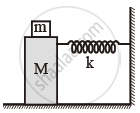Advertisements
Advertisements
प्रश्न
let us take the position of mass when the spring is unstretched as x = 0, and the direction from left to right as the positive direction of the x-axis. Give x as a function of time t for the oscillating mass if at the moment we start the stopwatch (t = 0), the mass is
(a) at the mean position,
(b) at the maximum stretched position, and
(c) at the maximum compressed position.
In what way do these functions for SHM differ from each other, in frequency, in amplitude or the initial phase?
उत्तर १
(a) x = 2sin 20t
(b) x = 2cos 20t
(c) x = –2cos 20t
The functions have the same frequency and amplitude, but different initial phases.
Distance travelled by the mass sideways, A = 2.0 cm
Force constant of the spring, k = 1200 N m–1
Mass, m = 3 kg
Angular frequency of oscillation:
`omega = sqrt(k/m)`
`= sqrt(1200/3)= sqrt400 = 20 rad s^(-1)`
a) When the mass is at the mean position, initial phase is 0.
Displacement, x = Asin ωt
= 2sin 20t
b) At the maximum stretched position, the mass is toward the extreme right. Hence, the initial phase is `pi/2`
Displacement , `x = Asin(omegat + pi/2)`
`= 2sin (20t + pi/2)`
= 2cos 20t
(c) At the maximum compressed position, the mass is toward the extreme left. Hence, the initial phase is `(3pi)/2`
Displacement, `x = Asin(omegat + 3pi/2)`
`= 2sin (20t + 3pi/2) = - 2 cos 20 t`
The functions have the same frequency (`20/(2pi) Hz`) and amplitude (2 cm), but different initial phases `(0, pi/2, (3pi)/2)`
उत्तर २
a =2 cm, omega = `sqrt(k/m) = sqrt(1200/3) s^(-1)= 20s^(-1)`
a) Since time s measured from mean position
b) At the maximum stretched position, tyhe body is at the extreme right position. The initial phase is `pi/2`
`:. x = a sin (omegat + pi/2) = a cos omegat = 2 cos 20 t`
c) At the maximum compressed position, the body is at the extreme left position. The initial phase is `(3pi)/2`
`:. x = a sin (omegat + (3pi)/2) = - a cosomegat = - 2 cos 20t`
APPEARS IN
संबंधित प्रश्न
If the metal bob of a simple pendulum is replaced by a wooden bob of the same size, then its time period will.....................
- increase
- remain same
- decrease
- first increase and then decrease.
The phase difference between displacement and acceleration of a particle performing S.H.M. is _______.
(A) `pi/2rad`
(B) π rad
(C) 2π rad
(D)`(3pi)/2rad`
Answer the following questions:
A man with a wristwatch on his hand falls from the top of a tower. Does the watch give correct time during the free fall?
Show that motion of bob of the pendulum with small amplitude is linear S.H.M. Hence obtain an expression for its period. What are the factors on which its period depends?
The period of oscillation of a simple pendulum of constant length at the surface of the earth is T. Its time period inside mine will be ______.
The relation between acceleration and displacement of four particles are given below: Which one of the particles is executing simple harmonic motion?
When will the motion of a simple pendulum be simple harmonic?
A cylindrical log of wood of height h and area of cross-section A floats in water. It is pressed and then released. Show that the log would execute S.H.M. with a time period. `T = 2πsqrt(m/(Apg))` where m is mass of the body and ρ is density of the liquid.
A tunnel is dug through the centre of the Earth. Show that a body of mass ‘m’ when dropped from rest from one end of the tunnel will execute simple harmonic motion.
In the given figure, a mass M is attached to a horizontal spring which is fixed on one side to a rigid support. The spring constant of the spring is k. The mass oscillates on a frictionless surface with time period T and amplitude A. When the mass is in equilibrium position, as shown in the figure, another mass m is gently fixed upon it. The new amplitude of oscillation will be:

